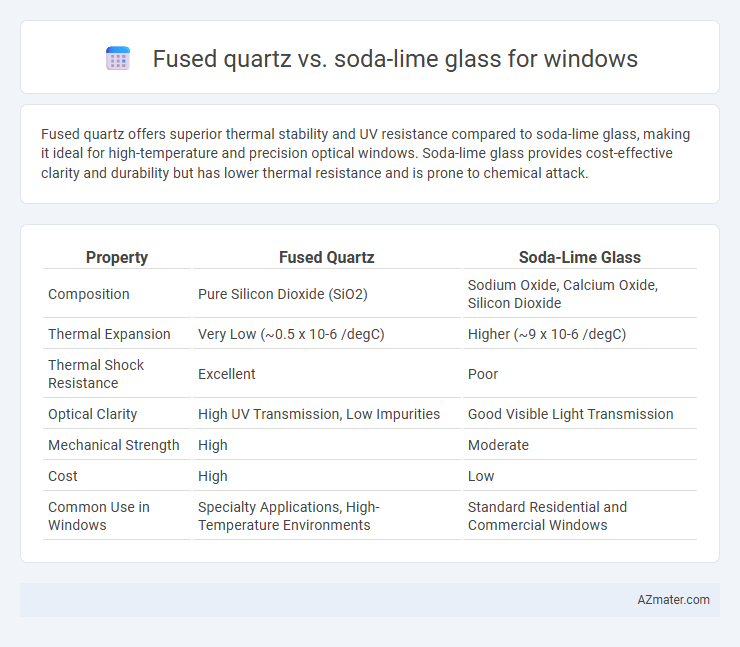Fused quartz offers superior thermal stability and UV resistance compared to soda-lime glass, making it ideal for high-temperature and precision optical windows. Soda-lime glass provides cost-effective clarity and durability but has lower thermal resistance and is prone to chemical attack.
Table of Comparison
| Property | Fused Quartz | Soda-Lime Glass |
|---|---|---|
| Composition | Pure Silicon Dioxide (SiO2) | Sodium Oxide, Calcium Oxide, Silicon Dioxide |
| Thermal Expansion | Very Low (~0.5 x 10-6 /degC) | Higher (~9 x 10-6 /degC) |
| Thermal Shock Resistance | Excellent | Poor |
| Optical Clarity | High UV Transmission, Low Impurities | Good Visible Light Transmission |
| Mechanical Strength | High | Moderate |
| Cost | High | Low |
| Common Use in Windows | Specialty Applications, High-Temperature Environments | Standard Residential and Commercial Windows |
Introduction to Fused Quartz and Soda–Lime Glass
Fused quartz is a high-purity, non-crystalline form of silicon dioxide known for its exceptional thermal stability, low thermal expansion, and excellent optical transparency, making it ideal for demanding window applications exposed to extreme temperatures or UV radiation. Soda-lime glass, the most common type of glass composed primarily of sodium oxide, lime, and silica, offers cost-effective production with good mechanical strength and moderate thermal resistance, suitable for standard residential and commercial window installations. The choice between fused quartz and soda-lime glass depends on specific performance requirements such as temperature resistance, optical clarity, and budget constraints.
Composition and Manufacturing Differences
Fused quartz is composed almost entirely of pure silicon dioxide (SiO2), produced by melting high-purity quartz crystals at temperatures above 2000degC, resulting in a highly transparent, low-thermal-expansion material ideal for specialized windows. Soda-lime glass consists primarily of silica (SiO2), with significant amounts of sodium oxide (Na2O) and calcium oxide (CaO), manufactured through melting sand, soda ash, and limestone at around 1500degC, producing a more economical but less thermally stable glass. The absence of alkali metals in fused quartz grants superior thermal shock resistance and optical clarity compared to soda-lime glass, which is more susceptible to thermal stress and weathering.
Optical Clarity and Transparency
Fused quartz offers superior optical clarity and transparency compared to soda-lime glass, featuring a higher transmission rate of ultraviolet and visible light with minimal distortion. Its low impurity levels and uniform molecular structure reduce light scattering, making it ideal for precision optical applications and high-performance windows. Soda-lime glass, while cheaper and widely used, exhibits lower UV transmission and slightly higher haze, limiting its effectiveness in environments requiring maximum optical clarity.
Thermal Resistance and Stability
Fused quartz offers superior thermal resistance with a melting point around 1,650degC, significantly higher than soda-lime glass, which melts near 1,400degC, making it ideal for high-temperature environments. Its thermal stability ensures minimal expansion and excellent performance under rapid temperature changes, while soda-lime glass is prone to thermal shock and distortion due to higher thermal expansion coefficients. These properties make fused quartz the preferred choice for applications requiring exceptional durability and consistent clarity at elevated temperatures.
Mechanical Strength and Durability
Fused quartz exhibits superior mechanical strength and durability compared to soda-lime glass, making it highly resistant to thermal shock and mechanical stress in window applications. Its high melting point and low thermal expansion coefficient contribute to enhanced resistance against cracking and deformation under fluctuating temperatures. In contrast, soda-lime glass, while more cost-effective, tends to have lower mechanical strength and is more susceptible to impact damage and weathering over time.
Chemical Resistance Comparison
Fused quartz exhibits superior chemical resistance compared to soda-lime glass, with exceptional durability against acids, alkalis, and solvents due to its high purity and low metallic oxide content. Soda-lime glass, containing higher levels of sodium oxide and calcium oxide, tends to degrade or leach when exposed to harsh chemicals, leading to surface corrosion and loss of transparency over time. This makes fused quartz the preferred material for windows in chemically aggressive environments such as laboratories and industrial settings requiring long-term stability and clarity.
Cost and Availability
Fused quartz is significantly more expensive than soda-lime glass due to its high purity and specialized manufacturing process, making it less accessible for widespread use in windows. Soda-lime glass, the most common type of glass, is widely available and cost-effective, dominating the market for standard window applications. The lower cost and easy mass production of soda-lime glass ensure its preference in residential and commercial window installations over fused quartz.
Common Applications for Windows
Fused quartz is commonly used for high-performance windows in scientific instruments, aerospace, and industrial settings due to its superior thermal resistance and optical clarity. Soda-lime glass dominates residential and commercial window applications because of its cost-effectiveness and sufficient durability for everyday use. Both materials serve distinct market needs, with fused quartz preferred for specialized environments and soda-lime glass for standard building windows.
Environmental Impact and Sustainability
Fused quartz offers superior environmental benefits compared to soda-lime glass due to its higher durability and thermal resistance, resulting in a longer lifespan and reduced replacement frequency. The production of fused quartz involves lower energy consumption over its lifecycle, while soda-lime glass manufacturing emits higher CO2 levels because of raw material calcination and batch melting processes. Recycling rates are generally higher for soda-lime glass, but the extended usability and lower thermal degradation of fused quartz contribute to better overall sustainability in window applications.
Choosing the Right Material for Your Window Needs
Fused quartz offers exceptional thermal stability and high resistance to temperature fluctuations, making it ideal for windows exposed to extreme heat or rapid temperature changes. Soda-lime glass provides cost-effective, durable performance suitable for standard residential and commercial windows with moderate thermal requirements. Selecting the right material depends on balancing budget constraints with performance needs, where fused quartz is favored for specialized, high-performance applications, and soda-lime glass meets everyday window demands efficiently.

Infographic: Fused quartz vs Soda–lime glass for Window
 azmater.com
azmater.com